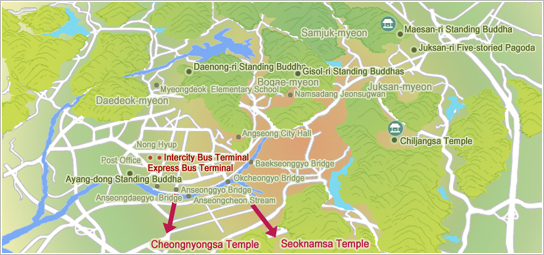< Commanding and Splendid Temples >
The first temple we reached was Chiljangsa Temple, probably built during the Silla Dynasty. Located at the foot of Mt. Chilhyeonsan, the cozy old retreat shone under the bright summer sun, brightening our hearts. The paint on the main hall, Daeungjeon, had peeled away to reveal the natural wood tones and charm of an old building.
Origin of the Name of the Temple : Since the 11th century, the mountain has been called Chilhyeon (seven wise men) based on a legend that the monk Hyesoguksa redeemed and converted seven criminals, who stayed at the temple Chiljang, and became wise men. The temple is a treasure trove of invaluable cultural assets such as Hyesoguksabi Monument, honoring the monk’s achievements, and Cheoldanggan. |
 |
 |
| Chiljangsa Temple |
Hyesoguksabi Monument |
|
| Tale of Hyesoguksabi Monument : Next to the Hyesoguksabi Monument is a turtle with a dragon’s head. Atop the turtle’s shell is the spot on which to place the monument and carved clouds surround it. The turtle seems to be flying to paradise with the monument on its back, expressing the sublime creativity of ancient Korean artisans. The Hyesoguksabi Monument is cracked down the middle. Legend has it that when Japanese commander Kato came to the temple during the Imjin War, an old monk appeared and reprimanded him. The infuriated commander took out his sword and struck the monk. Hyesoguksa disappeared and the monument cracked, spilling blood, and Kato fled in terror. |
|
How to Get There: Chiljangsa Temple
|
Anseong Intercity Bus Terminal → Take a bus for Juksan and get off at Juksan → Take a bus or taxi to Chiljang-ri |
|
| Next, we went to Seoknamsa Temple, which is deep in the woods. We arrived late at night and enjoyed a cup of tea with the principal monk. Since it was the first time any of us had slept in a temple, we felt a sense of amazement as though we had escaped the mundane world and were one with nature. The next day, we got up at 4am for Buddhist prayers and meditation. After purifying our minds, we took a walk around the temple and breathed in the fresh air of the early morning. We could almost feel our hearts being cleansed. |
 |
 |
| Seoknamsa Temple |
The Inside of Seoknamsa Temple |
|
How to Get There: Seoknamsa Temple
|
Anseong Intercity Bus Terminal → Take a bus for Sangjung-ri at the bus stop in front of old Housing Bank (Jutaek Eunhaeng) in downtown Anseong (Bus every one hour) |
|
| Our last stop was Cheongnyongsa Temple. Still preserving the ruins of the original buildings from the Goryeo period, the simple traditional ambience of this small temple made us all feel welcome and relaxed. The main hall, or Daeungjeon, has been designated national treasure no. 824. A notable feature of the hall is the natural curve of the wooden support beam, which creates a beautiful impression. |
 |
 |
| Cheongnyongsa Temple |
The Inside of Cheongnyongsa Temple |
|
How to Get There: Cheongnyongsa Temple
|
Anseong Intercity Bus Terminal → At the bus stop for Seoun-myeon, take a bus for Cheongnyongsa Temple (10 daily departures) |
|

















